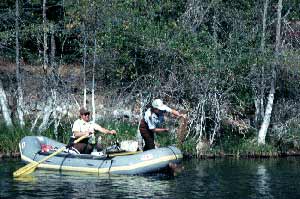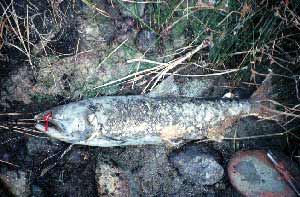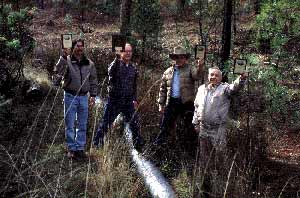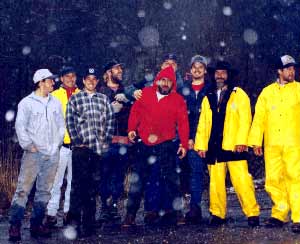
|
|

|
|
Contents
Salmon Spawning in the Trinity Riverby Jay Glase,US Fish and Wildlife Service Beginning in late September, and continuing until the end of December, the Trinity County Resource Conservation District (RCD) and the US Fish and Wildlife Service (USFWS) conducted a chinook salmon spawner carcass survey in the Trinity River. The survey extended from the Lewiston dam downstream to the confluence with the North Fork of the Trinity. Ten tributaries within that expanse of the Trinity were also surveyed on October 1st through late December. In recent years, this survey has been conducted by the California Department of Fish and Game (CDFG) and included in their annual reports of management efforts on the Trinity. This year however, with the uncertainty of funding from the Trinity River Restoration Program, CDFG was not able to complete these surveys. RCD and USFWS realized that conducting counts provided valuable information for tracking long term trends of salmon populations in the Trinity River. As with the spawner counts, CDFG was not able to install their fish weir in the Trinity River at Willow Creek early enough to count the spring run of chinook salmon in the Trinity. However, early observations of high numbers of spring run chinook this past summer gave further testimony that this could be an important year to collect information on spawning adult salmon.
Ron Smith and Nadine Metcalf count salmon carcasses Each week, two person crews rafted three to five sections of the river counting chinook salmon carcasses. Another crew walked several of the side channels along the river and two crew members walked the lower sections of ten tributaries. For the first four weeks of the survey, salmon redds (areas in gravel where the salmon deposit their eggs for incubation) were also counted and marked with small, bright green rocks. This was done to determine distribution of the spawning in the river. The redds are fairly easy to distinguish shortly after construction. Gravel in the redd generally appears much brighter than the surrounding areas since it is cleaned of fine sediment and algae by the female during redd construction. Salmon eggs in the redds are very susceptible to damage if the redd is disturbed. A person’s poorly placed foot could destroy up to 80% of the eggs in a redd. After four weeks, there were so many redds to mark that carcass counting was seriously slowed. It was decided that efficient data was more beneficial resulting in the discontinuation of redd counts.
A salmon tagged with flagging documents the week and Crews also looked for fish marked with a clipped fin indicating that it might be a hatchery fish. Marked fish also have a small wire tag that is coded with specific information inserted in their nose before they are released from the hatchery. If a potential hatchery fish was located, the head was removed for later tag examination. The crews also looked for fish that had been flagged in previous weeks and they recorded information on flag and ring color. The recovery of these marked fish is used to estimate the density of fish in the river. By color coding the rings by zone, the density within each zone of river surveyed can be determined. By the fourth week of the survey (October 17-21) the crews were processing over 1000 fish per week between the Lewiston dam and the one lane bridge in Lewiston, a distance of approximately 1.5 miles. The number of fish counted remained high throughout the survey. Although not all of the information has been analyzed, preliminary estimates indicate that by early December, there had been from 50,000 to 60,000 chinook salmon in the mainstem Trinity from Lewiston dam to the North Fork Trinity this fall. Coho salmon also showed up in strong numbers in late November. Streams such as Deadwood Creek had coho in such high numbers that it was difficult for the fish to locate adequate areas for spawning without digging up other redds. The abundance of fish led to requests from the public for an extended fishing season. Although this did not happen, the carcasses in the river certainly did not go to waste. The nutrients from all of these fish are an important part of the river's food web as aquatic insects and other organisms feed on the carcasses. These organisms will in turn be fed upon and help to sustain the young salmon that were produced by the numerous salmon in the river this year. It is good to see so many fish in the Trinity River, but it is vital to remember this is just one season. It takes several years of healthy runs to regain sustainable populations. The ultimate health of the salmon runs and the river system directly corresponds to the return of naturally produced (or wild) fish to the river system. The Trinity River system evolved with a specific genetic stock of salmon that were well adapted to this river, although it is likely various introductions of non-native salmon has occurred. To date, the relative numbers of wild and hatchery salmon that returned to the upper Trinity this year have not been determined; however, preliminary estimates indicate that numbers of wild salmon may have been substantial. The fish populations in this river are subject to the whims of nature such as periods of drought, floods and changing ocean conditions. Water management decisions also have major effects on the salmon. Subtle changes in either can be magnified into great impacts on regional fisheries. Resource Conservation District Wins Awardsby Noreen Doyas,Project Manager Trinity County Resource Conservation District (TCRCD) received a 1994 Goodyear/National Association of Conservation Districts (NACD) Award at the annual California Association of Resource Conservation Districts (CARCD) meeting held in Sacramento recently. This award is given to Resource Conservation Districts that exemplify the highest standards of conservation. Offered since 1947, the award program has promoted efforts to conserve soil, water, forest, wildlife and other natural resources. Each of the 3,000 conservation districts nationwide is eligible to receive this award once every six years. This year Goodyear Tire and Rubber Co. and the National Association of Conservation Districts bestowed 57 awards across the country, three of which were located in California.
RCD's Goodyear Award displayed by Board members, Greg Lowden, As one of the winners, the TCRCD recognized an outstanding cooperator from among the landowners who worked with the district in implementing restoration projects. Steve and Cindy Beck, owners of Carr Creek Ranch in Hayfork, were chosen to receive the Outstanding Cooperator Award for their work as the demonstration project for the Hayfork Basin. Work on their ranch during 1994 and 1995 included a riparian habitat improvement project aimed at reducing water temperature and increasing summer flows to improve the fisheries in the basin. Over 1,200 trees were planted along the riparian zone, 3,200 feet of riparian corridor protection fencing was installed, and 1,700 feet of an irrigation ditch was piped to improve water delivery efficiency. The award was presented to the Becks by members of the Trinity County RCD board which includes, Greg Lowden, president; Patrick Truman, vice president; Rose Owens, Doug Nowacki and Ken Jones. Patrick Truman was also presented the California Director of the Year Award by the California RCD Employees Association. Elena Letton was elected Area I CARCD employee representative for 17 districts in Northern California. Special Forest Products Workshopby Randi Anderson,Education Coordinator A Special Forest Products Workshop was held in Willow Creek this past summer. Seventy three people attended, representing a broad array of perspectives. The harvesting of Special Forest Products (SFP) is gaining momentum as communities make the shift away from timber based economies. SFP harvesting includes gathering and selling plants or plant parts for medicinal uses, floral design, food, artistic needs, and aesthetics. The harvesting is carried out on public lands (National Forest lands primarily) and the jobs created by these activities could contribute significantly to the depressed job markets of many counties. There are some real concerns, however, because people’s enthusiasm for gathering and marketing SFPs has outrun the planning process. The ecological consequences of harvesting are not thoroughly understood and many people are questioning the wisdom of readily opening the forest to the gathering demands that seem imminent. The intent of the workshop was to discuss and examine how we, as resource professionals and inhabitants of the environment, can move forward with awareness and knowledge while also acknowledging the job creating potential of SFP harvesting. There are many questions regarding "sustainability" within the framework of this form of land use: what can be harvested, how much can be harvested, what will it affect, what are the interconnections amongst the species, how often and when can harvesting occur, etc. A great deal will be learned as SFP harvesting proceeds and as the results are monitored, but we must be able to anticipate situations rather than learning through retrospect. It is a question of attitudes and perspectives. The words of Dennis Martinez of the Indigenous People’s Restoration Network provide guidance: “Harvesting must further ecological restoration rather than further economic value”. If intentions are market driven, which tends to occur in our culture, there is a risk of being blind to ecological consequences. The concept of harvesting herbs and shrubs seems benign enough, but even the removal of nutrients and biomass normally provided to the environment when plants die back each season, creates a major shift in the ecology. A cautionary note here is very appropriate. Through the discussion it became clear, a sound permit system must be put in place because demands for SFPs are currently greater than supplies and each National Forest could potentially be overrun with harvesters. It was suggested that creating a permit system that issues stewardship permits might work well. Somewhat akin to mining claims, these permits could serve to define a time frame and a location for specific SFP claims. Harvesting would be limited to the permittee(s) and information and training about SFP harvesting and stewardship would be provided. Under this plan each National Forest could determine the number of harvesters and could provide specific guidance about harvesting ethics and techniques, but even this plan has its problems. What ethic will drive the decisions of the people in charge of training the permittees? Will it be ecologically sound? Will they pass on to the permittees the sense of balance necessary to maintain the integrity of the ecosystem? Will harvesting permits accommodate the strengths and weaknesses of specific forests? Will monitoring the results of harvesting take place? Since the harvesting of SFP’s on a large scale is a new concept, establishing a monitoring program is important to help catch mistakes more readily and to facilitate the relaying of successful practices as well. How will accountability be maintained? Enforce-ment becomes an issue here as well. The fundamental subject during the workshop became one of world views - native and non-native. This received significant discussion time and the differences helped broaden the conceptual base from which to proceed with SFP harvesting. The non-native world view tends to be driven by the market and by a compilation of individual facts while the native world view tends to be driven by questions of spirituality and relationality. For many of us plants are viewed as commodities. For native people they are a way of life. The native people present at the workshop, as well as some non-native people, raised the issue of how these differences could be reconciled to some extent and incorporated into one whole. The acknowledgment of the differences seems indicative of a larger movement in our psyches towards truly addressing our society’s predominant frame of reference which seems to lack all the components necessary for healthy environmental decisions. It seems poetic that the native people all over the world are being called upon to lend their insights to the predominant world view. I stress this because even with a subject that seems so placid as the harvesting of special forest products, exploitation can occur if it is approached from only an economic and scientific awareness. The evolution of thinking points towards a more complementary relationship between these two world views. This trend is exciting because it implies further movement towards compassion and understanding on many levels - for the land and between different cultures. The conference ended with a sense of hope and appreciation that the process of communication had begun. Differences and concerns were aired as well as positive aspects of SFP, but much more work must be done before large scale SFP harvesting can be carried out as a sound ecological practice. SPI Gives a Helping Hand to Educationby Randi Anderson,Education Coordinator The Sierra Pacific Industries mill in Hayfork generously donated boards to be used by the Douglas City school children for their bird house building project. The children plan on putting the birdhouses up on a private cooperator’s land early this Spring hoping to encourage the nesting of certain species. They plan to study the birds that utilize the houses. Our thanks goes to the mill for facilitating and supporting the project. Wilderness Lends New Perspectives on Careersby Randi Anderson,Education Coordinator Late this Fall, Randi Anderson, RCD’s Education Coordinator, joined Lynn Mayer’s MECCA club on a day hike up Canyon Creek. MECCA stands for Making Electives Count Towards Career Achievement and is designed to expose highschool females to a wide variety of potential careers. Lynn hopes to break down gender barriers to career choices by exposing her students to jobs not normally pursued by women. The group talked about jobs in wilderness, botanical and restoration fields . More specifically they discussed the value and strength of women’s perspectives and explored how they can contribute to and support a healthy society. Over the course of the day the discussion evolved from a practical one into a philosophical one and the students readily shared experiences and insights about their lives and futures. This Spring, Randi, Lynn and her students hope to make some botanical hikes and delve deeper into the importance of women’s career and life choices. RCD’s Watershed Restoration Crewby Randi Anderson, Dana Sandifer, and Cynthia Tarwater
Inclement weather is the norm for RCD's intrepid This past season a great deal of watershed restoration and erosion control work was done by the Resource Conservation District crews. One crew, consisting of three to five Hayfork residents, worked in Hayfork under the supervision of Charlie Gacek. Charlie’s crew worked on a project with the Natural Resources Conservation Service (NRCS) in response to a landowner’s request for conservation assistance along Carr Creek. The creek had moved out of its old stream bed and was scouring into pastureland. A plan was designed by NRCS for returning Carr Creek to its original channel. Once the equipment work was completed, the crews stabilized the banks with willows and cottonwoods. They also seeded and mulched the disturbed areas. In other Hayfork Valley streams, where high water temperatures are a problem, the crews planted conifers, cottonwoods, maples, dogwoods, and alders to promote the growth of a canopy over the stream. Eventually, the shade of this riparian canopy will reduce the water temperatures, which will in turn, improve fish habitat. Other work implemented by the Hayfork crew involved a fencing project on ranch land adjacent to Salt Creek. Approximately 5200 linear feet of fencing was installed along the streambanks to protect the riparian zone from the impact of cattle. Heavy cattle impacts can degrade water quality and cause streambank erosion as well as increase water temperatures by reducing the canopy cover. Another RCD crew, consisting of eight to fourteen members, worked in Grass Valley Creek under the supervision of Larry Cooper. Their work involved treating disturbed areas after primary equipment treatment had been done. Much of the equipment work this year involved removing roads no longer used, outsloping maintained roads, upgrading culverts, landing/road crossing excavations, construction of several sediment basins, excavation of Hamilton Ponds at the mouth of Grass Valley Creek, and cleaning out the sediment basins adjacent to Rte 299 and along Trinity Dam Boulevard. After this work was done, the crews seeded, mulched and fertilized any newly exposed ground. They also recontoured some banks by hand and stabilized them with logs and woody material. The crew also repaired and refined structures that had been damaged by the winter storms, built check dams in channels to capture sediment, and cleaned out channels laden with sediment. Where access prohibited the use of equipment, the crew restored areas by hand. This involved hiking in up to two miles, digging waterbars, clearing out channels, redefining the natural path of water run-off, stabilizing and planting banks, and building numerous headcut structures to prevent gullies from further migration and erosion. This season’s planting was foreshortened by a few unusual circumstances. Late rain delayed planting until December 7th and a shortage of plants due to flooding at one of the nurseries curtailed planting by December 22nd. Much of the planting was planned to occur in the barren areas of Corral Creek, but this became impossible because access was blocked when a creek crossing was washed out by a heavy rain storm. Even with these extenuating circumstances, the crew planted 20,000 grasses, shrubs, and trees. AmeriCorps Getting Things Doneby Gabrielle Carroll,AmeriCorps Community Coordinator The AmeriCorps Program is a national service initiative in which members work on community service projects, focusing on such issues as environment, education, health and safety. In return, AmeriCorps members receive a living stipend, educational award, and perhaps most importantly, numerous life enriching experiences. The Trinity River Basin Watershed Project, is one such program funded by AmeriCorps. The Watershed Project utilizes an integrated, hands-on K-12 science curriculum, known as Adopt-A-Watershed, which allows students to engage in field studies and restoration projects within their adopted watershed. The students not only gain a greater understanding of science as it is made relevant and applicable to their lives, but also develop a sense of stewardship towards their community and environment. Students then complete the cycle as they take this knowledge one step further and participate in public education projects in which the students become the teachers that educate the greater community. The implementation of the program is based on school and community collaboration. Project coordination is critical for success. Community Coordinators are the essential link between teachers, natural resource professionals and community volunteers. There are currently six community coordinators serving the Trinity River Basin. This first quarter, which started in September 1995, the Watershed Project was able to coordinate 14 projects with 451 students, assist 24 teachers and recruit 48 volunteers. Heather Jones is the Community Coordinator for the South Fork Basin. Working together with Patricia Nickerson and her third grade class, Heather organized a riparian vegetation study along Big Creek. This particular project was unique in that the study took place on private land. Local private landowner participation was essential because creek access to sufficiently vegetated riparian areas in which to carry out the study was limited. The Watershed Project is always looking for opportunities to develop new partnerships to strengthen the community web. Until the coordination of this project, private landowners had not been significantly represented. David May, Community Coordinator for Junction City, Cox Bar and Burnt Ranch, organized a soil erosion project at the Bluebird Mine with students from Junction City Elementary School. The early hydraulic mining practices essentially left the area along Canyon Creek barren of vegetation. TCRCD’s Randi Anderson and Cynthia Tarwater assisted David May with identifying and prescribing a remedy for a hillside in desperate need of attention. Deep gullies were being carved into the slope and the upcoming winter storms would only make the situation worse. The erosion would not only impact past projects, but sediment would fill in pond habitat for three threatened species; the yellow legged frog, the western pond turtle, and the willow fly catcher. Kathleen Graham’s 4th-6th grade students, with the day’s seasonal showers, enthusiastically worked together with the AmeriCorps Service Crew to lay down straw, scatter grass seed, and build a check dam in an effort to mitigate the rain’s effect on the slope. The AmeriCorps Service Crew is a unique facet of the Watershed project. The 12 person labor crew serve as mentors for students in restoration projects and are also called upon to assist the community in a multitude of capacities. To date, the soil erosion project at the Blue Bird Mine has helped stabilize the banks. David May and the children will continue to monitor their work and will perform additional conservation work with the assistance of the RCD as the situation requires. The Watershed Project welcomes community participation and support. If you would like to volunteer or receive more information about the Trinity River Basin Watershed Project, please call 623-2823. Local Students Enter CompetitionA team from Hayfork High participated in the State Envirothon Competition in Monterey, April 2-4, 1996. Team members were Arthur Yount, Bix Lane, Alice Hart, Lori Barni, and Cynara Kidwell. Hayfork High’s Alan Brainard, with resource professionals Scott White (Planning), US Forest Service’s Tricia Bratcher (Wildlife), Roger Jaegel (Forestry), and NRCS’s Jim Spear (Soils) helped the students prepare for the competition. The "Envirojacks" matched wits with other teams throughout the state on topics relating to: Aquatics, Soils, Forestry, Wildlife, & Land Use Issues. The competition included written, oral, and hands-on testing. Our students performed very well, ranking at the top in several of the categories. Many of the students plan on competing next year. The Mojave Desert team won the competition and will go on to the Nationals in Mahoney Park, Nebraska. Suggested Reading List:Sharing Nature With Children, Joseph Cornell, Dawn Publications, 1979. Before the Wilderness, compiled and edited by Kat Anderson and Thomas C. Blackburn, Ballena Press, 1993. Terrestrial Plant Ecology, Barbour, M., Burk, J., and Pitts, W..,Benjamin/Cummings Publishing Co., 1987. Handbook for Forestry and Ranch Roads: A Guide for Planning, Designing, Constructing, Reconstructing, Maintaining and Closing Wildland Roads, prepared by Hagans, D. and Weaver, Wm. Mendocino County RCD, June 1994. The Geography of Childhood, Nabhan,G. and Trimble, S. Beacon Press, 1994. Roadside Geology of Northern California, Alt,D. and Hyndman, D. Mountain Press Publishing, 1975.
Return to the Trinity County RCD Home Page
|





